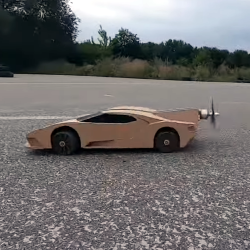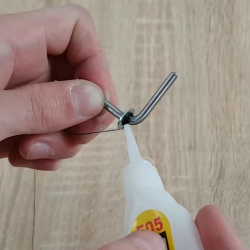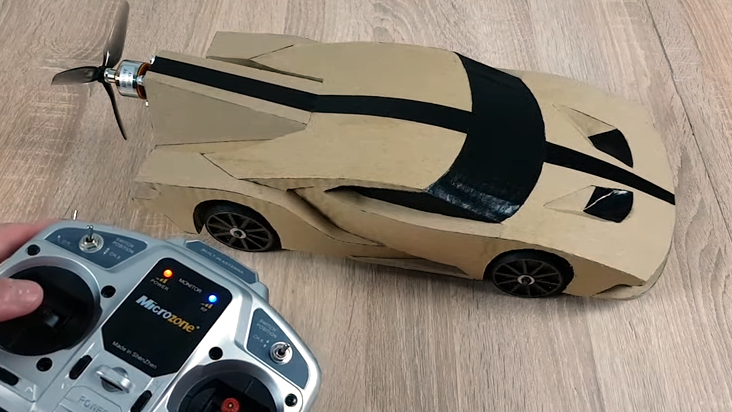 [Kryzer Channel] takes making a DIY RC car to a whole new level with this prop-driven electric car that is made almost entirely out of cardboard (YouTube video, also embedded below.) By attaching an electric motor with a push prop to the back of the car, [Kryzer] avoids the need for any kind of drive system or gearing. Steering works normally thanks to some scratch-built linkages, but the brake solution is especially clever.
[Kryzer Channel] takes making a DIY RC car to a whole new level with this prop-driven electric car that is made almost entirely out of cardboard (YouTube video, also embedded below.) By attaching an electric motor with a push prop to the back of the car, [Kryzer] avoids the need for any kind of drive system or gearing. Steering works normally thanks to some scratch-built linkages, but the brake solution is especially clever.
Braking is done by having a stocky servo push a reinforced stub downward, out of a hole in the center of the car. This provides friction against the road surface. After all, on an RC car a functional brake is simply not optional. Cutting the throttle and coasting to a stop works for a plane, but just won’t do for a car.

Layers of corrugated cardboard and hot glue make up the bulk of the car body, and some of the assembly techniques shown off are really slick and make the video really worth a watch. For example, the construction of the wheels (starting around 2:24) demonstrates making them almost entirely out of cardboard, saturated with CA glue for reinforcement, with a power drill acting as a makeshift lathe for trimming everything down. A section of rubber inner tube provides the tire surface and a piece of hard plastic makes a durable hub. Wraps of thread saturated in CA glue, shown here, is another technique that shows up in several places and is used in lieu of any sort of fasteners.
The well-edited video (embedded below) is chock full of clever assembly and construction. Unsurprisingly, this is not [Krazer]’s first cardboard vehicle: their video channel has other impressive cardboard models and racers to show off.
Cardboard is an often under-rated prototyping material that offers loads of advantages. We’ve also seen the results of saturating paper products with CA glue before, like in this paper slug-flinging cardboard gun.















Cool design, is it model after any existing automobiles?
Yes the new ford GT40 I believe. IIRC the real car has active aerodynamics as well, so this is an especially fitting choice for a prop powered car.
Why not reverse the motor?
probably a weight thing
“After all, on an RC car a functional brake is simply not optional.”
What? It sure is optional – gas powered RC cars have actual brakes – typically a disc brake setup with actual pad material that’s mounted to the transmission or main driveshaft.
“not optional” “not an option”, you pretty much reinforced the statement
This is fake. You can’t use CA glue that much without sticking your fingers together. Been there, tried that, nope.
Heh. Yes – he’s like a magician. Clean hands throughout the video, no glued bearings, and dead-on precision manual assembly. Like an 80’s movie where the hero beats up a roomfull of bad guys without getting his hair messed up. It looks like this guy has been building fun things from cardboard and glue for a while. Skills.
Pretty cool stuff – I’ve seen a few cool projects here made from cardboard, but this is one of the slickest.
Looking at his youtube channel; This is not his first rodeo. Quite a collection of cardboard RC stuff
That’s why there are so many cuts in the video, this was actually shot over a period of 14 months to give the fingers time to heal.
for your next model…. Could you steer it with thrust vectoring?
Why?
Those are some awesome fabrication skills, even if the hot melt glue gun was cold during the video. Last time I tried that sort of CA work, the cat ended up stuck to the ceiling.
Watching the end got me wondering if there are any RC comm protocols that allow handing control over to a remote operator, similar to how cell towers can hand a moving cell phone to the next tower.
When I was a kid, I was given a gas-powered Cox Shrike prop-driven model car. (when those cars would just go round and round on a tether) . It was really well made, a work of art, and I couldn’t stand the idea of it getting beat up. So my grandfather and I made a wood and Erector-set based air powered pusher car using the Shrike’s .038 motor and prop, with the rest of the Shrike model in the house for safe keeping. The wood/Erector set car was pretty slow, but it was fun anyway.
With bare fingers
How it was done in the 1950’s: http://underlandia.com/index.php/2020/07/18/propeller-driven-speedsters/
Reminds me of something I built as a child: The chassis was a 4 wheeled platform made from fisher-technik parts. Then a small (12 to 15cm) plastic propeller and a toy motor. To have some control over the contraption, I had a remote “kill switch”: That was a low performance 27MHz single channel toy radio control out of a junk bin I wired to de energize the motor when I pressed the button. There was no steering or brake. Of course the vehicle needed some more meters to come to a stop. So I had to stop the motor in time, the all over track length I had, was about 10m from the hall into the kitchen. That was, if the vehicle ran straight enough to roll through the kitchen door. More than once it crashed into some piece of furniture, but no real damage was done.